Many pests, and pathogens, are adept at overwintering among leaf litter, dormant buds, and bark. This means that for fruit trees the dormant season is often the best time to try to remedy pest problems noted in the orchard during the previous year.

Last spring we were looking forward to seeing our pear trees in bloom…but something sinister was lurking in the leaf buds
Last season, as the new leaves were emerging on our pear trees, we found a widespread pest problem with the leaves.

The emerging leaves on some of our pear trees were showing a tremendous number of raised nodules, or blisters (click any image to enlarge)
At first, from a distance, we initially thought we had an irrigation problem as the leaves on the pear trees all had a wilted appearance. As we got closer we could see the leaves were discolored, and deformed, and we thought perhaps this damage was the result of the Pear Saw Flies we’d seen previously. The Pear Sawfly larvae feed on the leaf surface, and skeletonize the leaves on a variety of fruit trees.
However, closer inspection showed the leaves actually weren’t skeletonized, and the damage was more nodular in appearance. Blistered. At first we weren’t sure what we were dealing with. A fungus? A bacterial, or viral pathogen? Whatever it was, the damage was extensive, seemingly almost overnight, and was rapidly decimating newly emerging leaves.
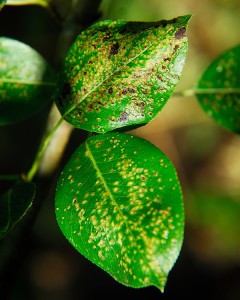
The nodular damage looked different, and was more widespread, than the skeletonized leaves we’d seen previously
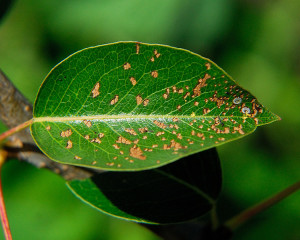
Compare that to the Pear Sawfly damage, where the leaf is pitted, a result of the leaf surface being chewed away
However, this time it turns out that the damage was caused by an Eriophyid mite, the Pear Leaf Blister Mite (Phytoptus pyri) [1].
Unlike the Pear Sawfly larvae, which are easy to see with the naked eye, the worm-like Pear Blister Mites are invisible without the use of a hand lens. They’re tiny, measuring just over 200 microns in length.
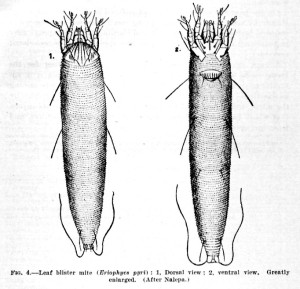
The mites are difficult to see, but this sketch shows the worm-like structure of the mites (Image: Public Domain)
However, they make up for their small size with sheer numbers, and appetite. Pear Leaf Blister Mites are most commonly found in orchards with young trees, and/or trees that have not been sprayed during the dormant season. Our trees fell into both categories. Our orchard is only a few years old, and we don’t spray our trees with pesticides, or dormant oil as we hadn’t had cause to.
The female mites overwinter at the base of developing leaf buds. During the period of bud swell in late winter, the mites invade the developing leaf tissue.
During the bloom period, in spring, as the leaves begin to emerge, clusters of blisters begin to appear on the leaves, the result of the mites feeding on the leaf tissue [3]. Initially the blisters are green to pink in color.

Note that not all the leaves are equivalently affected at first. Here one leaf is showing blister damage, and an adjacent leaf appears unaffected
However, as the blisters age they darken to a deep brown.
As additional generations of mites are produced during the growing season, the damage can spread throughout the orchard. The foliar damage can be quite extensive, and very plainly visible, even from a distance. I’m sorry to say that this was one of our pear trees in late spring last year, a very sorry sight…

Eventually, the damage can become extensive. Our Seckel and Warren Pears were most severely affected last season
Fruit that develops on an infested tree may also be affected, and show signs of russeting on the skin.
All of our pear cultivars experienced at least some damage, but in our orchard the most severely affected varieties last season were our dessert pears, Warren, and Seckel. For commercial growers, one recommendation is to grow naturally russeted pear varieties, like Bosc, presumably so any minor damage is less noticeable. Of course, you might remember that our Bosc pear tree was anything but resistant to voles! Ah, the joys of farming. It’s always something, isn’t it?
The blister mite damage in our orchard last season was downright ugly, and the most severe leaf disorder we’ve seen in fruiting trees, except perhaps for peach leaf curl (which is why we only grow PLC-resistant peaches here).
We don’t use pesticides in our orchard, and unfortunately, biological controls are reportedly not effective for Pear Leaf Blister Mites, as a significant population of the mites reside within the blisters where they’re protected from predation.
The good news, though, is that Pear Leaf Blister Mites can be controlled effectively, and organically, with simple sulfur sprays, or dormant oil sprays to smother the overwintering mites.

This season we’re trying an application of dormant oil to tackle the Pear Blister Mite problem in our orchard
With the severity of damage last season, there was no question that we needed to treat the trees this dormant season, so we’ve elected to try a simple dormant oil spray. It was important not to time the treatment too late, because by the time the leaf buds begin to swell, the female mites will already be invading the forming leaf tissue, where the spray can’t reach them. Ideally, we knew we wanted the trees to be denuded of leaves, but to spray before the buds swell in late winter. Hopefully, we caught our trees in time this season, but now we’re waiting anxiously, with fingers crossed, to see how the leaves will look as they unfurl this spring. Once the trees start to push we’ll let you know if the dormant oil treatment worked!
———————-
[1] UC IPM Online: UC Pest Management Guidelines – Pearleaf Blister Mite
[2] Larsen, H.J. April 2011. Leaf Blister Mites. Colorado State University.
[3] Keifer, H.H., Baker, E.W, Kono, T., Delfinado, M., and Styer W. 1982. An Illustrated Guide to Plant Abnormalities Caused by Eriophyid Mites in North America. USDA-ARS Agriculture Handbook Number 573.

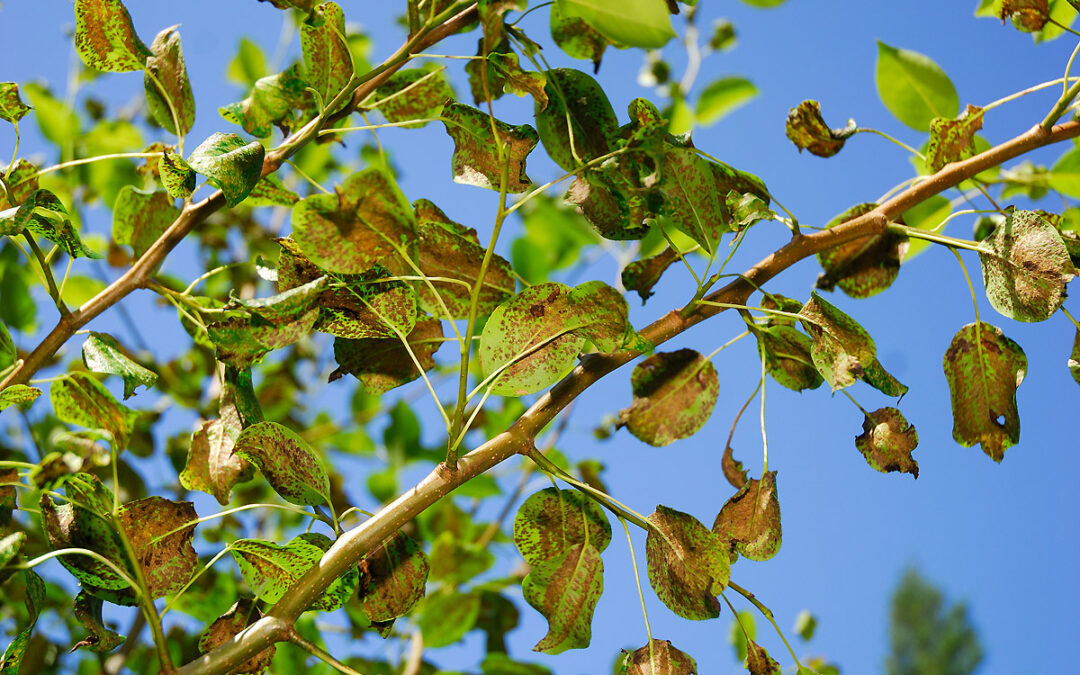
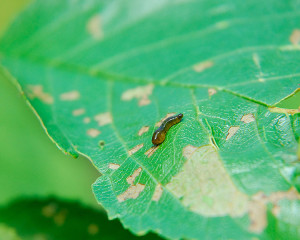


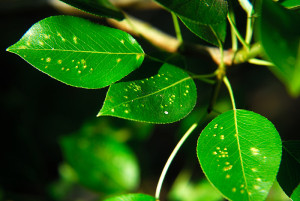
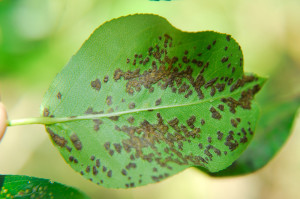
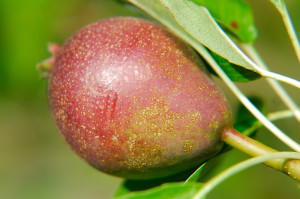
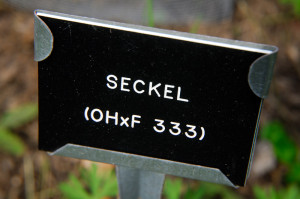







Boy Clare it is just one thing after another…so much to know and research and then do especially to keep it organic and not use chemicals. Keeping my fingers crossed.
It’s funny, we’ve grown fruit trees, from the ‘lazy-person’s’ perspective before, no problem. However, this particular issue is not uncommon in California, in part because pears are commonly grown in backyards. This enables pests like these, in the occasionally un-sprayed yard, to gain a foothold, and spread to neighboring properties. As much as my lazy-side doesn’t want to spray, in this case, I see the value of using a benign dormant oil spray. It’s worth an hour or two of time investment to squelch this during the dormant season!
Very informative! I can tell a big difference on our apple trees and many shrubs when we use dormant oil. We plan to spray this weekend, if it’s not raining.
I’m hoping the dormant oil will work. If our timing is right, I expect it should at least help, although it may take a couple of seasons to correct the problem. 🙂
Gosh, that is one ugly mite! Hope the sulfur spray takes care of it. We had Plum Curculio issues with our Apple trees (at our old house many years ago). I remember finding some helpful solutions through Gardens Alive. Good luck!
The degree of disfigurement on the leaves was quite startling last year. I think we got so busy with other things early in the season, that those mites managed to sneak up on us. Not this year though! 😉
I’ll be interested to see how the dormant oil works for you. When we first inherited our apple orchard this was one of the things I looked into but so far we’ve never gotten to spraying. I notice some similar issues with our leaves though so this would likely be a help to us.
The trick with dormant oil, at least for pests such as this, is timing. I’m hoping we got our timing right. We should now in a month or so! We did go ahead an spray the apples too this year, which we haven’t done in years past, just as insurance.
That looks like a pain!
Our biggest pear problem is fire blight — it was terrible last year on our pear and Asian pear. The European pear (‘Keifer’) is probably becoming timber/smoker wood after this season. I’m going to replace it with an Asian persimmon. The pear has a weird habit of only blooming on the last 8″ of each branch tip (in spite of being a 20′ tall tree) and none of the pear experts around here have a clue what is going on with it. Then it drops the few fruits it even sets. Not a winner!
I was concerned about fire blight here when we first planted our pears. So far, though, we’ve been lucky. Rather than take your pear tree out entirely, have you considered hard-pruning it, and grafting new pear varieties to it? I’m presuming, of course, that the root stock is fine. That said though, I think a persimmon sounds like a fine idea too 😉
This is such a unsightly and damaging problem. I have seen it on field trees. I hope you are successful at cubing it.
I hope so too, this infestation was downright UGLY last spring! I was embarrassed to have anyone visit the orchard 😳
Boy, it’s always something, isn’t it? No end to the pests and varmints. I think I might have a bit of that on my Asian pear trees. But being terminally lazy, I have never sprayed with dormant oil spray. Maybe this will be my year to spray. LOL.
Some days I’m amazed we ever harvest anything. I think the trick is to over-plant in an attempt out-pace everything else that wants to share in the bounty! 😉